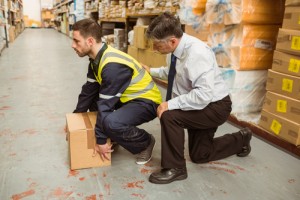
The transition to chronic pain and ultimate work disability can quickly be precipitated by exposure to continued unsafe lifting in workers as well as other work related psychosocial factors.
Musculoskeletal Physiotherapists in private practice (e.g. in Canada) are regularly required to assess lifting capacity and subsequently provide occupational lifting restrictions during rehabilitation.
A variety of Physical and Functional Capacity Evaluation tests of which lifting forms a major part are used. Occupational lifting seems to not only serve as a prognostic factor for the aggravation of LBP but also has a subsequent influence on sickness absence and work disability.
In keeping with evidence base practice, they would like to know what is the current research evidence for exposure to lifting at work and the incidence of back pain? How much, how often, how long is too much? What is the current acceptable lifting threshold?
Then, the Elf came up with this paper! A meta-analysis combines the results of similar studies mathematically to provide a summary best estimate of any true effect.
What could be better!
Here’s what they did
To quantify the effect of exposure to work related lifting on the incidence of non- specific Low Back Pain (NSLBP), the authors searched PubMed and Embase databases for publications in English from inception till April 2014. They then;
- Quantified the effect of work related lifting in terms of duration, frequency and intensity.
- Included: Original Longitudinal cohort studies that expressed the effect of the work related lifting on the incidence of NSLBP as a risk estimate e.g. Relative Risk (RR), Odds Ration (OR) or Prevalence ratio (PR).
- Excluded: intervention Studies, Reviews, editorials or letters.
- Assessed the quality of each study’s methodology using the STROBE statement (Strengthening The Reporting of Observational studies in Epidemiology)
- Conducted a Meta analysis by pooling risk estimates, expressed in ORs or 95% intervals, for the effect of frequency and intensity but not for duration on the incidence of LBP.
- Conducted a Health Impact assessment by comparing the annual incidence of LBP between workers exposed to lifting and non- exposed workers.
- Assessed Publication bias with a funnel plot.
Here’s what they found
- 8 original longitudinal cohort studies out of 2631 reference hits on the databases.
- Pooled ORs on the Intensity of lifting (10kg per day) in 6 out of the 8 studies was 1.11 (95% CI 1.05 to 1.18)
- Pooled ORs for the frequency of lifting (10 lifts per day) by calculating the exposure-response relationship for 3 out of 8 studies was 1.09 (95% CI 1.03 to 1.15)
- 1 study on Frequency of lifts and LBP did not provide a comparable exposure metric.
- 2 studies reported a positive association between duration of lifting and the incidence of LBP but exposure definitions were too different to conduct a meta- analysis
On Health Impact Assessment, they found for:
- Intensity: a relative increase of almost 25% (an extra annual increase of 4.32%) of LBP in workers who regularly lifted loads above 25kg compared to non-exposed workers.
- Frequency: a relative increase of about 20% (an extra annual increase of 3.5%) in the incidence of LBP in workers who regularly lifted loads more than 25 times per day compared to non- exposed workers.
- Asymmetry of the funnel plot, suggesting some publication bias.
The authors concluded
Intensity and frequency of lifting were significantly associated with annual incidences of LBP. Exposure to lifting more than 25kg or lifting more than 25 times per day can potentially lead to increased annual incidences of LBP by 4.3% and 3.5% respectively.

Exposure to lifting more than 25kg or lifting more than 25 times per day can potentially lead to increased annual incidences of Low Back Pain by 4.3% and 3.5% respectively.
The Musculoskeletal Elf’s view

A Meta analysis is be best suited to Randomized controlled trials (RCTs) however it is not uncommon to see a meta analysis of observational research such as cohort studies in this instance.
When used to summarise effects from observational studies, results may give spurious precision. Hence a meta-analysis of observational studies may best be used to examine the various influences of distinct methodological factors in such instances.
The report of this meta analysis is promising in that it calls attention to some parameters of exposure in occupational lifting, i.e. frequency, duration and intensity for the purposes of research as opposed to treating exposure as a dichotomous entity of non-exposure and exposure to lifting!
However, in this analysis, assumptions of similarities (e.g. population and outcome descriptions) had to be made to minimise heterogeneity of the small number of included studies so that a statistical pooling could be done. There were also indications of potential publication bias, which could result in an over-estimation of the effects found in this Meta analysis.
Essentially, the results of this promising meta analysis should be interpreted with caution and in context.
Although previous intervention studies have not successfully demonstrated significant reductions in the incidence of low back pain with the reduction of exposure to occupational lifting, this does not negate the need for further research. This situation however highlights the need for a better standardization of categories, operational definitions and objective outcome measurements amongst other parameters. This will facilitate reproducible research in different contexts. Results of such studies may be better combined to assess for a true effect in a Meta-analysis.
What do you think?
- Do you assess injured workers for lifting capacity to inform the restrictions on a return to work program?
- What parameters of exposure to lifting do you assess for and or highlight in your recommendations?
- Do you refer to any published guideline in your recommendations?
- Or are you a researcher in this area of study?
Send us your views on this blog and become part of the ever expanding Musculoskeletal Elf community. Post your comment below, or get in touch via social media (Facebook, Twitter, LinkedIn, Google+).
Links
- Coenen P, Gouttebarge V, van der Burght AS, van Dieën JH, Frings-Dresen MH, van der Beek AJ, Burdorf A. The effect of lifting during work on low back pain: a health impact assessment based on a meta-analysis. Occup Environ Med. 2014 Dec;71(12):871-7. doi: 10.1136/oemed-2014-102346. Epub 2014 Aug 27. Review. PMID: 25165395 [abstract]
- von Elm E, Altman DG, Egger M, Pocock SJ, Gøtzsche PC, Vandenbroucke JP; STROBE Initiative. The Strengthening the Reporting of Observational Studies in Epidemiology (STROBE) Statement: guidelines for reporting observational studies. Int J Surg. 2014 Dec;12(12):1495-9. doi: 10.1016/j.ijsu.2014.07.013. Epub 2014 Jul 18. PMID: 25046131 [abstract]
- PRISMA statement
- EQUATOR Network

The effect of lifting during work on Low Back Pain http://t.co/3RAOytmQsf
Baggage handlers at airports or in some hotels I see lifting large, heavy cases many times with a poor technique. Perhaps some research with that cohort group would be good.
The effects of lifting at work low back pain http://t.co/Xy6RCxafWv
The effect of lifting during work on #LowBackPain http://t.co/BXCoKV5gUN @theCSP @thecspstudents
@MSK_Elf @paintoolkit2 just simply where load lifted is stirred with excess of individuals ability, mixed with a few yellow flags.
The effect of lifting during work on #LowBackPain http://t.co/iYgalAM8Ru @FfWEurope @NIOSH @WorktoLive @SHPonline
The effect of lifting during work on #LowBackPain http://t.co/BXCoKVmRMl @painPhysio @PhysioPainAssoc
@MSK_Elf @painphysio @PhysioPainAssoc Stuart McGill did a lot on this – not too much, not too little was the summary I recall….
@NeilClark74 @MSK_Elf @PhysioPainAssoc And does that person have the tolerance for the load at that particular moment?
@painphysio @MSK_Elf @PhysioPainAssoc i like working in volume so if lifting 25kg once per min for 1 hour this = 1.7 tons Over a day??
@NeilClark74 @MSK_Elf @PhysioPainAssoc Wow! Who would be doing that?
@painphysio @MSK_Elf @PhysioPainAssoc someone in a gym for an hour of their own choice-no problem. Poorly paid job, no satisfaction #context
@NeilClark74 @MSK_Elf @PhysioPainAssoc very true
@MSK_Elf also repetitive lifting work maybe poorly paid and low job satisfaction. So is it the lifting, type of job/workplace/other factors?
True!
Lifting during work what’s effect #LowBackPain http://t.co/iYgalB3Kg4 @CochraneWork @CochraneBack @CochraneConsumr
The effect of lifting during work on Low Back Pain – meta-analysis of observational studies. By Abiodun Adefolarin https://t.co/ErkBpMdBP7